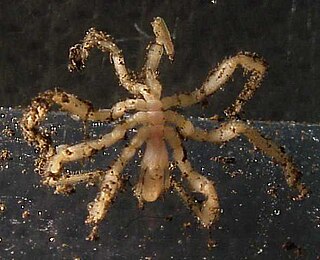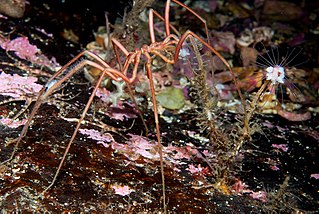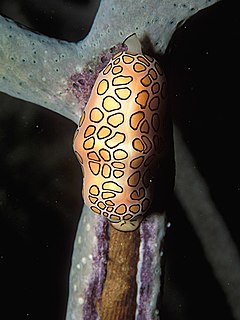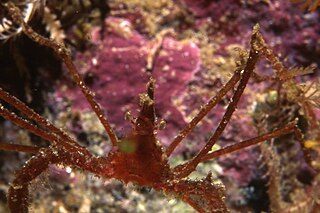
Wolf spiders are members of the family Lycosidae. They are robust and agile hunters with excellent eyesight. They live mostly in solitude, hunt alone, and do not spin webs. Some are opportunistic hunters, pouncing upon prey as they find it or chasing it over short distances; others wait for passing prey in or near the mouth of a burrow.

Sea spiders are marine arthropods of the order Pantopoda, belonging to the class Pycnogonida, hence they are also called pycnogonids. They are cosmopolitan, found in oceans around the world. There are over 1,300 known species, with legs ranging from 1 mm (0.04 in) to over 70 cm (2.3 ft). Most are toward the smaller end of this range in relatively shallow depths; however, they can grow to be quite large in Antarctic and deep waters.

Selenopidae, also called wall crab spiders, wall spiders and flatties, is a family of araneomorph spiders first described by Eugène Simon in 1897. It contains over 280 species in nine genera, of which Selenops is the most well-known. This family is just one of several families whose English name includes the phrase "crab spider". These spiders are often called "Flatties" due to their flattened dorsal profile. The Afrikaans name for these spiders is "Muurspinnekop."

The Japanese spider crab is a species of marine crab that lives in the waters around Japan. It has the largest leg-span of any arthropod. It goes through three main larval stages along with a prezoeal stage to grow to its great size.

Ocypode is a genus of ghost crabs found in the sandy shores of tropical and subtropical regions throughout the world. They have a box-like body, thick and elongated eyestalks, and one claw is larger than the other in both males and females. They inhabit deep burrows in the intertidal zone. They are primarily nocturnal, and are generalist scavengers and predators of small animals. The genus contains 21 species.

Nymphonidae is a family of sea spiders which has representatives in all the oceans. This family contains some 250 species, most of which are found in the genus Nymphon. Nymphonid bodies are between 1 and 15 mm long, the extent between the points of the legs reaching 150 mm. Most species are predators of hydroids. Like most sea spiders, all species in this family have four pairs of legs, except for Pentanymphon antarcticum, which has five pairs, and Sexanymphon mirabilis, which has six pairs.

The flamingo tongue snail is a species of small but brightly colored sea snail, a marine gastropod mollusk in the family Ovulidae, the cowry allies.

The Mediterranean mussel is a species of bivalve, a marine mollusc in the family Mytilidae. It is an invasive species in many parts of the world, and also an object of aquaculture.

Ocypode ryderi, also known as the pink ghost crab, is a species of ghost crab found on the east coast of Africa from the Eastern Cape Region to Kenya.

Cyphoma signatum, is a species of sea snail, a marine gastropod mollusk in the family Ovulidae, the ovulids, cowry allies or false cowries.This species was recently synonymised with Cyphoma gibbosum.

Achaeopsis spinulosa, the hotlips spider crab, is a species of crab in the family Inachidae, found only around the South African coast. It is the only species in the genus Achaeopsis.

Macropodia falcifera, the Cape long-legged spider crab, is a species of marine crab found around the South African coast. It is a member of the family Inachidae.

Nymphon is a genus of sea spiders in the family Nymphonidae.

Anthostella stephensoni, the violet-spotted anemone, is a species of sea anemone in the family Actiniidae.

The walking anemone, also known as the hedgehog anemone or sock anemone, is a species of sea anemones in the order Actiniaria. It is the only member of its genus, Preactis.

Macropodia rostrata, common names, the common spider crab, long-legged spider crab, long-legged crab, is a species of marine crab in the family Inachidae. The Macropodia Rostrata visually mimics many other types of small crabs with the exception of its long legs. By attaching algae to their thin legs, they can be confused with the stem of seaweed. This is both a defense mechanism and a predatory advantage, as unsuspecting fish will hide in seaweed beds from nearby predators. This behavior can be absent among larger crabs, and those that live at great depths like giant Japanese spider crabs.

Nymphon gracile is a species of sea spider first described by William Elford Leach in 1863. The species highly resembles other members of the genus Nymphon, and species identification from morphological traits alone is, therefore, a complex task.

Anilocra capensis is a species of parasitic isopod in the family Cymothoidae. It is endemic to southern Africa. The species preferentially attaches itself to the hottentot seabream.

The Marine biodiversity of South Africa is the variety of living organisms that live in the seas off the coast of South Africa. It includes genetic, species and ecosystems biodiversity in a range of habitats spread over a range of ecologically varied regions, influenced by the geomorphology of the seabed and circulation of major and local water masses, which distribute both living organisms and nutrients in complex and time-variable patterns.


















